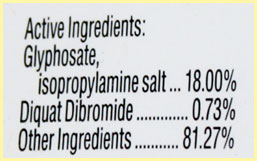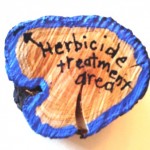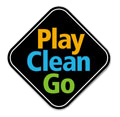It seems to me that many folks removing buckthorn are not aware of how to effectively and economically apply herbicide. Often with the cut-stump method, the entire stump is painted or sprayed with herbicide when only buckthorn’s cambium layer is affected by herbicide application. The cambium is a microscopic tree layer that sits just inside the inner bark. In the photo below, I illustrated the herbicide treatment area with blue paint. Notice the black arrow pointing to a barely visible line denoting the location of the cambium layer.
Only the outer circumference of freshly cut stumps, where the cambium layer is located, needs to be treated with herbicide. Some older herbicide labels recommend drilling holes in the middle of the trunk and pouring in herbicide – egad! Since this area is the dead heartwood responsible only for holding the tree upright, I wonder why this application would be suggested. Hmmm . . . perhaps a financial motivation on the part of the manufacturer? Back to the point that only the cambium is responsible for drawing down and storing energy into buckthorn’s root structure. When herbicide is applied to the cambium layer it hitches a ride downward to kill the buckthorn root structure and avoid regrowth. You can save time and money by limiting herbicide application to the cambium, not the whole stump.
Another factor affecting my successful buckthorn removal is the herbicide’s active ingredient. I prefer to use a herbicide containing 18-20% glyphosate as the active ingredient. (The reasons I prefer to cut-stump treat buckthorn with glyphosate will be saved for a future blog segment. Something to look forward to!) Glyphosate is sold under various brand names but the most common is Roundup. Whether purchasing Roundup or a generic brand, I check the manufacturer’s product label in the bottom right corner of the herbicide container for the product’s Active Ingredients.

Copyright 2012 Landscape Restoration, Inc. Herbicide label – active ingredient listing
For cut-stump treatment of buckthorn, I want the active ingredient to be glyphosate at 18% to 20% as shown in the photo at right. I use this concentration as is to fill my Buckthorn Blaster applicator and apply herbicide. The 4-ounce Buckthorn Blaster easily keeps me going for 4 to 6 hours of woodland fun. Buckthorn Blasters can be purchased online at www.landscape-restoration.com.
Now that you know my tips to save time and money at buckthorn removal, don’t let your door knob hit you in the rear as you rush outside to eradicate buckthorn. Happy buckthorn busting:)
NOTE: I store my herbicide in an area protected from freezing during winter so the effectiveness will not be diminished.
Cheryl Jirik
Landscape Restoration, Inc.



